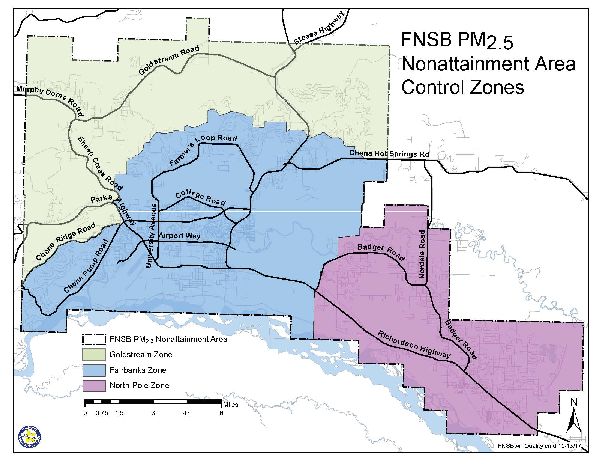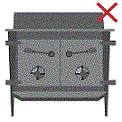burn
Real Estate requirement - Fairbanks North Star Borough PM2.5 Nonattainment Area
This requirement affects real estate transactions in the Fairbanks North Star Borough fine particulate matter (PM2.5) nonattainment area. It requires the registration of all compliant solid fuel-fired heating devices and the removal or replacement of non-compliant solid fuel-fired heating devices before the sale, lease, or conveyance of property within the nonattainment area. The regulations are intended to improve air quality by reducing the number of older, more polluting solid fuel-fired heating devices in the area over time.
UPDATE – On October 2, 2020, a new requirement went into effect. For a summary of the requirement – click the ADEC Real Estate Contingency Measure Handout. For a copy of the EPA Action – click the EPA Federal Register Notice. This web page has been updated to reflect the new changes.
- Wood and Pellet Fired Devices
- -Effective June 9, 2017 -
- Coal-Fired Devices
- - Effective January 12, 2018 -
- Outdoor Hydronic Heaters
- -Effective January 8, 2020 -
The Environmental Protection Agency (EPA) redesignated the PM2.5 nonattainment area from 'moderate' to 'serious' effective June 9, 2017. See: Federal register notice (PDF).
Real Estate Licensees
DEC regulations and the State Air Quality Control Plan (also known as the State Implementation Plan or SIP) require solid fuel-fired heating devices including wood stoves, pellet stoves, coal stoves and hydronic heaters, to be removed from a property before sale, lease, or conveyance in the Fairbanks North Star Borough PM2.5 nonattainment area unless they meet current emission standards and age requirements. This includes devices located anywhere on the property including inside the home, in a garage, and in outbuildings. Coal fired heaters, and outdoor cordwood hydronic heaters are not allowed to be sold and should be removed or replaced before sale, lease, or conveyance. Advisory Letters from DEC
In determining if a device may stay on the property, two pieces of information are necessary: emission rating and manufacturer date.
How to Identify EPA-Certified Wood Stoves and Pellet Stoves
Manufacturers of EPA-certified wood and pellet stoves are required to attach a permanent label to the stove. This label is usually located on the back of the stove and will include information about the stove including confirmation that the stove meets EPA particulate matter emission standards (see picture). If you cannot locate this tag, it is likely not an EPA-certified stove. Another sign that a stove is an older un-certified model is a lack of windows. Wood and pellet stoves that do not have EPA-certification must be removed from the property before the property is sold. Replacement devices are not required. However, if a new wood or pellet stove will be installed as a replacement, it must meet the state’s current emission standards for new installations.
For devices with a label, the easiest way to tell if a device must be removed is as follows:
Step 1: Check manufacture label for an emission rate, if the emission rate is equal to or less than 2.0 grams per hour, the device may stay. Ensure that the device is registered, and no further action is required.
Step 2: If the emission rate is greater than 2.0 grams per hour, then:
Current calendar year minus manufactured year must be less than 25 years.
Example1:2020 –1995 = 25 years, all devices manufactured in 1995, 1994, 1993 ... and so on need to be removed or replaced.
Example 2:2021–1996 = 25 years, all devices manufactured in 1996, 1995, 1994 ... need to be removed or replaced.

Cordwood Hydronic Heaters and Coal Fired Devices
As of January 8, 2020, cordwood hydronic heaters and most coal fired devices must be removed before closing. The removed devices are to be rendered inoperable. No new devices of this type will be allowed to be sold and/or installed in the area. There is one exception, and that is if a coal fired device has a wintertime source test conducted and the source test results meet emission standards found in 18 AAC 50.079. Source test plans need to be reviewed and approved by the department and the department needs the opportunity to witness the source test in order for the source test to be considered valid.
Compliance Guidance
The following guidance should be used in order to meet the requirements of 18 AAC 50.077, 18 AAC 50.079 and the SIP - Devices required to be removed should be removed or replaced by the following times:
- For home or property sales: prior to the close of a sale (closing)
- For leases: before commencement of the lease term
Temporary Waivers
DEC may grant temporary waivers to this requirement on a case by case basis. DEC will consider the following factors when making a determination on a waiver request:
- Financial hardship information provided by the owner or operator;
- Technical feasibility information provided by the owner or operator;
- Potential impact to locations with populations sensitive to exposure to PM2.5 including hospitals, schools, child care facilities, health clinics, long-term care facilities, assisted living homes, and senior centers.
For questions regarding temporary waivers, please follow the process outlined on this page: Real Estate Requirement: Solid Fuel-Fired Heating Device Removal Requirement Exceptions and Request for Temporary Waiver Process
Contact: If you have any questions about this requirement or need assistance, please email: decburnwisealaska@alaska.gov or phone: 907-451-5172.
Property Owners, Buyers, & Landlords
DECregulations and the State Air Quality Control Plan (SIP) require solid fuel-fired heating devices including wood stoves, pellet stoves, coal stoves and hydronic heaters, to be removed from a property before sale, lease, or conveyance in the Fairbanks North Star Borough PM2.5 Nonattainment Area if they are 25 years old or older and their emission rating is greater than 2.0 grams per hour. The first step is to determine if they are EPA-certified or not.
How to Identify EPA-Certified Wood Stoves and Pellet Stoves
Manufacturers of EPA-certified wood and pellet stoves are required to attach a permanent label to the stove. This label is usually located on the back of the stove and will include information about the stove including confirmation that the stove meets EPA particulate matter emission standards (see picture). If you cannot locate this tag, it is likely not an EPA-certified stove. Another sign that a stove is an older un-certified model is a lack of windows. Wood and pellet stoves that do not have EPA-certification must be removed from the property before the property is sold. Replacement devices are not required. However, if a new wood or pellet stove will be installed as a replacement, it must meet the state’s current emission standards for new installations.

Once the label is found, the easiest way to tell if a device may stay is as follows:
Step 1: Check manufacture label for an emission rate, if the emission rate is equal to or less than 2.0 grams per hour, the device may stay. Ensure that the device is registered, and no further action is required.
Step 2: If the emission rate is greater than 2.0 grams per hour, then:
Current calendar year minus manufactured year must be less than 25 years.
Example1:2020 –1995 = 25 years, all devices manufactured in 1995, 1994, 1993 ... and so on need to be removed or replaced.
Example 2:2021–1996 = 25 years, all devices manufactured in 1996, 1995, 1994 ... need to be removed or replaced.
Cordwood Hydronic Heaters and Coal Fired Devices Cordwood hydronic heaters and most coal fired devices must be removed before closing. The removed devices are to be rendered inoperable. No new devices of this type will be allowed to be sold and installed in the area. There is one exception, and that is if a coal fired device has a wintertime source test conducted, and the source test results meet emission standards found in 18 AAC 50.079. Source test plans need to be reviewed and approved by the department and the department needs the opportunity to witness the source test in order for the source test to be considered valid.
What if I Used the Borough Change Out Program? If you obtained your device by participating in the Fairbanks North Star Borough Change Out program, the installed device is likely EPA-certified and the device was manufactured less than 25 years ago and does not need to be removed when you sell your property. However, be sure to check for the permanent label on the back of EPA-certified wood and pellet stoves for its emission rating. The current requirements are 2.0 g/hr and if your device has a rating greater than this your device will be required to be removed or replaced once it is 25 years old if the property it resides on is sold.
Compliance Guidance
The following guidance should be used in order to meet the requirements of 18 AAC 50.077, 18 AAC 50.079 and the SIP - devices required to be removed should be removed or replaced by the following times:
- For home or property sales: prior to the close of a sale (closing)
- For leases: before commencement of the lease term
Temporary Waivers
DEC may grant temporary waivers to this requirement on a case by case basis. DEC will consider the following factors when making a determination on a waiver request:
- Financial hardship information provided by the owner or operator;
- Technical feasibility information provided by the owner or operator;
- Potential impact to locations with populations sensitive to exposure to PM2.5 including hospitals, schools, child care facilities, health clinics, long-term care facilities, assisted living homes, and senior centers.
For questions regarding temporary waivers, please follow the process outlined on this page: Real Estate Requirement: Solid Fuel-Fired Heating Device Removal Requirement Exceptions and Request for Temporary Waiver Process
Contact:
If you have any questions about this requirement or need assistance, please email: decburnwisealaska@alaska.gov or phone: 907-451-5172.
What Solid Fuel-Fired Heating Devices Must Be Removed?
Solid fuel-fired heating devices including wood, pellet and coal stoves, hydronic heaters, fireplace inserts, and large devices with greater than 350,000 Btu per hour heat output are affected by this measure. Coal and hydronic heaters must be removed. All other devices, not exempted, that are 25 years old and have an emission rating of greater than 2.0 g/hr must be removed from the property before the property is sold, leased, or conveyed.
A solid fuel-fired heating device that is removed under this requirement, is not required to be replaced, but it must be rendered inoperable. However, if it is replaced with another solid fuel-fired heating device it must be replaced with a new device that meets the state’s current emission standards for new installations. Re-installations of removed devices are not allowed within the Fairbanks North Star Borough nonattainment area under 18 AAC 50.077 and 18 AAC 50.079.
There are some exceptions and the ability for temporary waivers under either 18 AAC 50.077(h), for wood and pellet stoves, or 18 AAC 50.079(e), for coal heaters. For more details: Real Estate Requirement: Solid Fuel-Fired Heating Device Removal Requirement Exceptions and Request for Temporary Waiver Process
What fireplace inserts may need to be removed?
Fireplace inserts that may need to be removed are those that are wood or pellet stoves designed to fit inside an existing fireplace. For examples and additional definitions please see: Fireplaces and Fireplace Inserts. Inserts that function as a wood or pellet stove should be EPA-certified.
For questions regarding a specific insert, please contact Cory McDonald at 907-451-5172.
The process for temporary waivers or exceptions may be found on this page: Real Estate Requirement: Solid Fuel-Fired Heating Device Removal Requirement Exceptions and Request for Temporary Waiver Process
Removed device - what to do with it? Process for Disposing Old Devices
What Solid Fuel-Fired Heating Devices Can Stay?
In determining whether a solid fuel-fired heating device can stay, first ensure the device has an EPA label. This label is critical to determine the manufacturer date and emission rate.
Once the label is found, the easiest way to tell if a device may stay is as follows:
Step 1: Check manufacture label for an emission rate, if the emission rate is equal to or less than 2.0 grams per hour, the device may stay. Ensure that the device is registered, and no further action is required.
Step 2: Current calendar year minus manufactured year must be less than 25 years. If the manufactured date is less than 25 years, the device may stay.
Example: 2020 –1996= 24 years, all devices manufactured in 1997, 1998, 1999 ... and so on, may stay (in this example).
All New Installations must meet current state’s Emission Standards
This requirement does not affect these types of devices:
- Fireplaces (without inserts)*
- Masonry Heaters*
- Oil-Fired Heaters
- Gas-Fired Heaters
*For examples and definitions, please see: Fireplaces and Fireplace Inserts.
Where
This requirement only affects real estate transactions located inside the Fairbanks North Star Borough PM2.5 Nonattainment Area (PDF)
DEC maintains a zoom-able online map (please allow a moment for the orange boundary layer to load) that allows users to view the boundaries of the Nonattainment Area over satellite imagery. This tool will help you determine if a property is affected by this requirement.

Regulations and State Air Quality Plan (SIP)
The regulation requirements are contained in 18 AAC 50.077 Standards for wood-fired heating devices (PDF), 18 AAC 50.079 Standards for coal-fired heating devices (PDF), and in the State Air Quality Plan (SIP) Section III.D.7.7.5.1.2 (PDF) (adopted by reference in 18 AAC 50.030 State air quality plan (PDF).
The regulations and SIPs addressing air quality in the Fairbanks North Star Borough PM2.5 nonattainment area have evolved from 2013 to present. All of the various regulation packages, comment periods, response to comments may be found at Previously Proposed Regulations. The history contained at this site documents the development and progression of the regulations addressing solid fuel devices over time.
The Clean Air Act (42 U.S.C. 7502(c)(9) (PDF)) requires states to adopt contingency measures as part of their air quality plans for nonattainment areas. These requirements must be designed to go into effect if an area does not attain the air quality standards in time. The latest contingency measure effective October 2, 2020 will over time increase the number of older devices required to be removed prior to closing. This additional group of devices being removed are those EPA certified devices that are 25 years and older with an emissions rating greater than 2.0 grams/hour.
These requirements found in the regulations and SIPs are designed to help improve air quality in the nonattainment area. Removal or replacement of older, more polluting, solid fuel-fired devices when a property is sold, leased, or conveyed will accelerate turnover and result in fewer of these devices operating in the area, reducing wood and coal smoke emissions.
Questions & Answers
If you have any questions or need assistance, please email: decburnwisealaska@alaska.gov or phone: 907-451-5172. Responses to general questions from the public will be available online and accessible through this web-page.
Click question below to show answer:
- Can I modify my multi-fuel heating device by disabling the wood fired portion to comply with the removal/replacement requirement of 18 AAC 50.077?
- No, it is not possible to guarantee that the solid fuel portion of the device is fully decommissioned without the possibility of being recommissioned/repaired. Therefore, the Department would only consider granting a temporary waiver in order to help with the eventual transition to either a compliant wood fired device or a non-wood burning device.
- What should I do if my device is not listed in the DEC approved device lists, but I believe it meets the regulatory requirements?
- Please see this web-page for more information: Real Estate Requirement: Solid Fuel-Fired Heating Device Removal Requirement Exceptions and Request for Temporary Waiver Process
- What must I submit to apply for a temporary waiver?
- Please see this web-page for more information: Curtailment Waiver and Exception Applications
- Do I need to remove or replace my fireplace when I sell my house?
- Fireplaces - No. This requirement does not affect fireplaces. They do not need to be removed or replaced. However, Fireplace Inserts, such as pellet stoves or wood stoves that fit into a fireplace chamber, ARE affected by this requirement and must be removed or replaced unless they meet emission criteria and are listed on one of several lists.
- What if I can't find the label or think it burned off?
- EPA certified devices are required to have a permanent label made of material that will last the lifetime of the wood heater. They must also be affixed in a manner that the label cannot be removed without damage. Typically these labels are metal with the make and model stamped in it. It is unlikely a label has burned off. The federal labeling requirements, which began in 1988, may be found at 40 CFR § 60.536 (PDF). If the label cannot not be found on the device (back, front, underneath, or hidden behind a panel), then it can be assumed the device is non-certified.
- Who is liable for compliance with these regulations?
- The regulations apply to the real estate professional's clients who are buying, selling, or leasing real estate with an affected heater. This new regulation is not any different from other issues real estate agents already face with respect to matters affecting real estate transactions. A realtor's duties to their clients and the grounds for disciplinary action by the Real Estate Commission are unchanged.
- How will DEC monitor compliance with these regulations?
- DEC will rely on complaints that the regulations have not been complied with.
- How will DEC handle complaints?
- DEC will investigate complaints to determine if there has been a violation of the regulation. DEC's goal is compliance and it will work with individuals to assist with compliance. Enforcement actions will be evaluated by DEC, in conjunction with the Department of Law, on a case-by-case basis.
Advisory Letters
In an effort to provide information about requirements before they are activated, DEC has reached out to Elected Officials and Real Estate Professionals. See documents below:
- May 17, 2016 - Letter to Elected Officials (PDF)
- May 19, 2016 - Letter to Real Estate Professionals (PDF)
- December 23, 2016 - 2nd Letter to Real Estate Professionals (PDF)
- May 11, 2017 - 3rd Letter to Real Estate Professionals (PDF)
- May 12, 2017 - Letter to Elected Officials (PDF)
- December 28, 2017 - 4th Letter to Real Estate Professionals (PDF)
- December 16, 2019 - 5th Letter to Real Estate Professionals (PDF)
- September 2, 2020 - 6th Letter to Real Estate Professionals
- October 15, 2021 - 7th Letter to Real Estate Professionals









 Indicates an external site.
Indicates an external site.